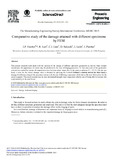Mostrar el registro sencillo del ítem
Comparative study of the damage attained with different specimens by FEM
| dc.creator | Fuertes Bonel, Juan Pablo | es_ES |
| dc.creator | Luri Irigoyen, Rodrigo | es_ES |
| dc.creator | Luis Pérez, Carmelo | es_ES |
| dc.creator | Salcedo Pérez, Daniel | es_ES |
| dc.creator | León Iriarte, Javier | es_ES |
| dc.creator | Puertas Arbizu, Ignacio | es_ES |
| dc.date.accessioned | 2017-10-30T11:14:39Z | |
| dc.date.available | 2017-10-30T11:14:39Z | |
| dc.date.issued | 2015 | |
| dc.identifier.issn | 1877-7058 (Print) | |
| dc.identifier.issn | 1877-7058 (Electronic) | |
| dc.identifier.uri | https://hdl.handle.net/2454/26073 | |
| dc.description | Trabajo presentado a The Manufacturing Engineering Society International Conference, MESIC 2015 (Barcelona) | es_ES |
| dc.description.abstract | This present research work deals with the analysis of the design of different specimen geometries so that by finite volume simulations, the appearance of cracks may be predicted in the case of forging processes. To this end, each of the geometries selected are studied by means of compression tests between plane shape dies in the same conditions (T = 25 ºC). On the one hand, a value for the critical damage value is obtained by applying the Cockroft-Latham’s criterion and on the other hand, a damage distribution along all the specimen volume with the aim of defining a specimen which shows the most likely place for the crack to appear. This crack location may be also determined through visual inspection with the aim of being able to evaluate this experimentally in the near future. | en |
| dc.description.sponsorship | The authors acknowledge the support given by the Spanish former Ministry of Economy and Competitiveness under the research project DPI2013-41954-P. | en |
| dc.format.extent | 7 p. | |
| dc.format.mimetype | application/pdf | en |
| dc.language.iso | eng | en |
| dc.publisher | Elsevier | en |
| dc.relation.ispartof | Procedia Engineering 132 (2015) 319 – 325 | en |
| dc.rights | © 2015 Published by Elsevier Ltd. This is an open access article under the CC BY-NC-ND license | en |
| dc.rights.uri | http://creativecommons.org/licenses/by-nc-nd/4.0/ | |
| dc.subject | Damage | en |
| dc.subject | Isothermal forging | en |
| dc.title | Comparative study of the damage attained with different specimens by FEM | en |
| dc.type | Contribución a congreso / Biltzarrerako ekarpena | es |
| dc.type | info:eu-repo/semantics/conferenceObject | en |
| dc.contributor.department | Ingeniería Mecánica, Energética y de Materiales | es_ES |
| dc.contributor.department | Mekanika, Energetika eta Materialen Ingeniaritza | eu |
| dc.rights.accessRights | Acceso abierto / Sarbide irekia | es |
| dc.rights.accessRights | info:eu-repo/semantics/openAccess | en |
| dc.identifier.doi | 10.1016/j.proeng.2015.12.501 | |
| dc.relation.projectID | info:eu-repo/grantAgreement/MINECO//DPI2013-41954-P/ES/ | en |
| dc.relation.publisherversion | https://doi.org/10.1016/j.proeng.2015.12.501 | |
| dc.type.version | Versión publicada / Argitaratu den bertsioa | es |
| dc.type.version | info:eu-repo/semantics/publishedVersion | en |



